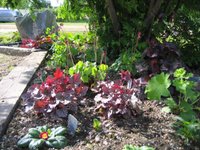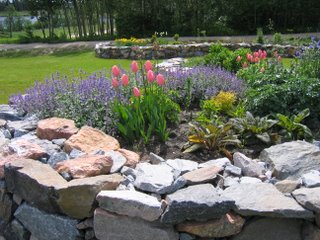 This is the garden question of the week. Of course they can, I say, and the situation should be remedied as soon as possible! Mr. Resident Lawnmower-Person disagrees. He is of the opinion that any combination of plants looks good together and flowers blend by the mere commonality of their "flowerness" (not his exact words). Of course, this same man requires consultation on which pants and shirts look okay together...
This is the garden question of the week. Of course they can, I say, and the situation should be remedied as soon as possible! Mr. Resident Lawnmower-Person disagrees. He is of the opinion that any combination of plants looks good together and flowers blend by the mere commonality of their "flowerness" (not his exact words). Of course, this same man requires consultation on which pants and shirts look okay together...So tonight I set about moving plants all over the yard in a need to restore color harmony. One particular color combination was polluting the garden aesthetic: Blue/purple-flowered Jacob's ladder and the Purple-leaf rose (Rosa glauca). How could I have left these two together for so long? I retch at the ugliness. I searched the net and found this pearl:
(1) Purple-foliage plants combine well with blue-grey foliage plants.
Plan: Remove Jacob's ladder. Will add an Artemisia schmidtiana "Silvermound" (from division of existing plants) in front of rose next spring. Divided a few Lamb's Ear (Stachys byzantia) and placed next to rose. Move a bunch of silver/purple leafed Coral Bells (Heuchera) to between rose and blue oat grass (blue-grey).
To illustrate my point: Center photo = bad combo, Side photos = show better options to combine with the rose (seen in center photo).
 Other garden pearls from my yard: NEVER plant tansy. It is an invasive weed that even several applications of Round-up can't destroy. Any bit of root grows a new plant. Yarrow (Achillea millefolium) is a close second in that regard.
Other garden pearls from my yard: NEVER plant tansy. It is an invasive weed that even several applications of Round-up can't destroy. Any bit of root grows a new plant. Yarrow (Achillea millefolium) is a close second in that regard.



 Pictured:
Pictured: 

















